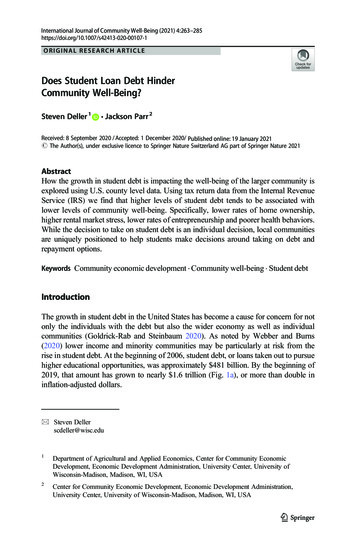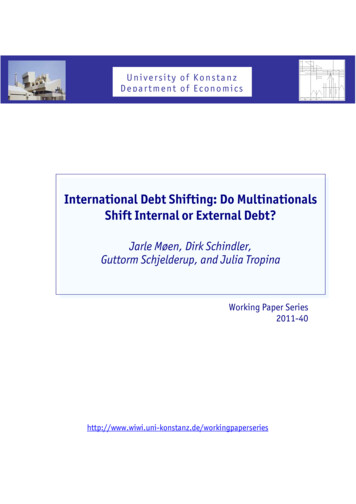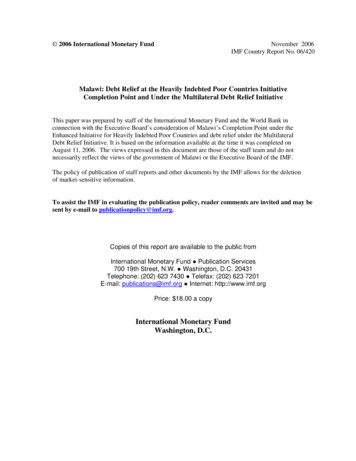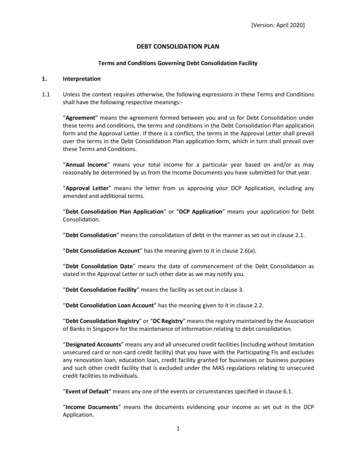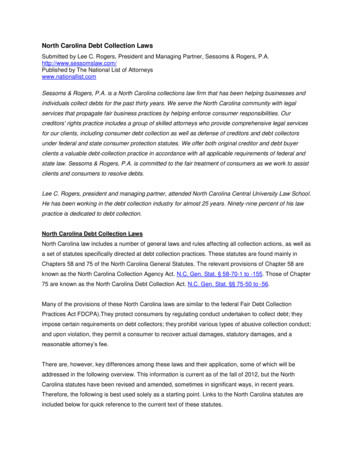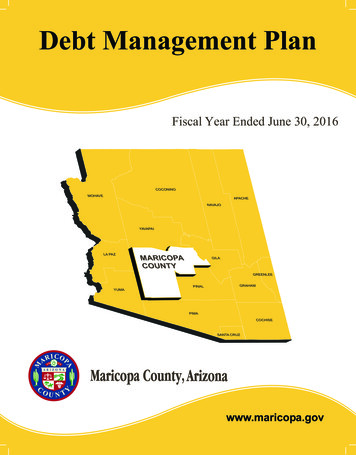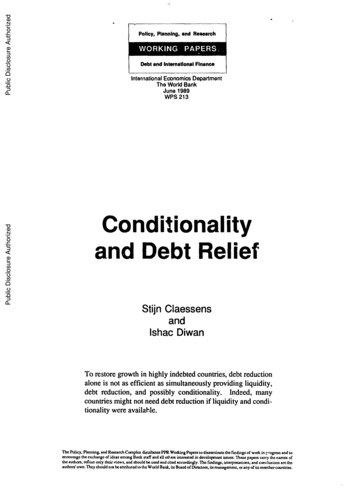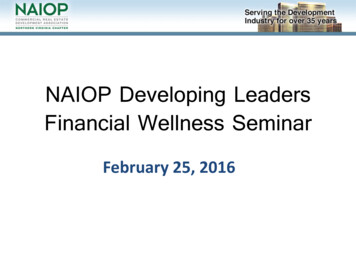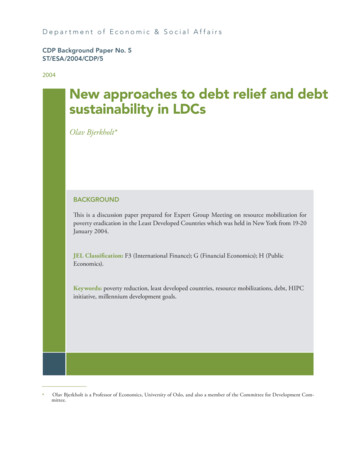
Transcription
Depar tment of Economic & Social Af fairsCDP Background Paper No. 5ST/ESA/2004/CDP/52004New approaches to debt relief and debtsustainability in LDCsOlav Bjerkholt*BACKGROUNDThis is a discussion paper prepared for Expert Group Meeting on resource mobilization forpoverty eradication in the Least Developed Countries which was held in New York from 19-20January 2004.JEL Classification: F3 (International Finance); G (Financial Economics); H (PublicEconomics).Keywords: poverty reduction, least developed countries, resource mobilizations, debt, HIPCinitiative, millennium development goals.*Olav Bjerkholt is a Professor of Economics, University of Oslo, and also a member of the Committee for Development Committee.
TABLE OF CONTENTSIntroduction. . . . . . . . . . . . . . . . . . . . . . . . . . . . . . . . . . . . . . . . . . . . . . . . . . . . . . . . . . . . . . . . . . . . . . . . . . . . . . . . . . . . . . . . . . . . 1The burden of debt and the benefits of debt relief. . . . . . . . . . . . . . . . . . . . . . . . . . . . . . . . . . . . . . . . . . . . . . . . . . . . . . . 3Structural causes of indebtedness in LDCs . . . . . . . . . . . . . . . . . . . . . . . . . . . . . . . . . . . . . . . . . . . . . . . . . . . . . . . . . . 3Debt relief as development aid. . . . . . . . . . . . . . . . . . . . . . . . . . . . . . . . . . . . . . . . . . . . . . . . . . . . . . . . . . . . . . . . . . . . . 5A brief history of the debt crisis. . . . . . . . . . . . . . . . . . . . . . . . . . . . . . . . . . . . . . . . . . . . . . . . . . . . . . . . . . . . . . . . . . . . . 7Implementation of the HIPC Initiative . . . . . . . . . . . . . . . . . . . . . . . . . . . . . . . . . . . . . . . . . . . . . . . . . . . . . . . . . . . . . . . . . . . 9The HIPC Initiative procedure . . . . . . . . . . . . . . . . . . . . . . . . . . . . . . . . . . . . . . . . . . . . . . . . . . . . . . . . . . . . . . . . . . . . . . 10Status of HIPC . . . . . . . . . . . . . . . . . . . . . . . . . . . . . . . . . . . . . . . . . . . . . . . . . . . . . . . . . . . . . . . . . . . . . . . . . . . . . . . . . . . . . 12Review of the HIPC Initiative . . . . . . . . . . . . . . . . . . . . . . . . . . . . . . . . . . . . . . . . . . . . . . . . . . . . . . . . . . . . . . . . . . . . . . . . . . . 13The concept of debt sustainability. . . . . . . . . . . . . . . . . . . . . . . . . . . . . . . . . . . . . . . . . . . . . . . . . . . . . . . . . . . . . . . . . . 14What is wrong with the HIPC Initiative?. . . . . . . . . . . . . . . . . . . . . . . . . . . . . . . . . . . . . . . . . . . . . . . . . . . . . . . . . . . . . 16An improved HIPC Initiative or a more radical approach?. . . . . . . . . . . . . . . . . . . . . . . . . . . . . . . . . . . . . . . . . . . . . . . . 18A doubly enhanced HIPC Initiative?. . . . . . . . . . . . . . . . . . . . . . . . . . . . . . . . . . . . . . . . . . . . . . . . . . . . . . . . . . . . . . . . . 19Starting from Millennium Development Goals. . . . . . . . . . . . . . . . . . . . . . . . . . . . . . . . . . . . . . . . . . . . . . . . . . . . . 20Conclusion: debt sustainability vs. sustainable development . . . . . . . . . . . . . . . . . . . . . . . . . . . . . . . . . . . . . . . . . . . . 21References . . . . . . . . . . . . . . . . . . . . . . . . . . . . . . . . . . . . . . . . . . . . . . . . . . . . . . . . . . . . . . . . . . . . . . . . . . . . . . . . . . . . . . . . . . . . 24Notes . . . . . . . . . . . . . . . . . . . . . . . . . . . . . . . . . . . . . . . . . . . . . . . . . . . . . . . . . . . . . . . . . . . . . . . . . . . . . . . . . . . . . . . . . . . . . . . . 26The CDP Background Paper Series is a collectionof peer-reviewed research papers focusing on the issues dealt with by the Committee for DevelopmentPolicy. The objective is to stimulate discussion onthe broad range of economic, social and environmental issues. The views and opinions expressedherein are those of the author and do not necessarily reflect those of the CDP nor the United NationsSecretariat. The designations and terminology employed may not conform to United Nations practice and do not imply the expression of any opinionwhatsoever on the part of the Organization.UNITED NATIONSDepartment of Economic and Social AffairsUN Secretariat, 405 East 42nd StreetNew York, N.Y. 10017, USAe-mail: pad/document cdp/cdp-background-paper-series/
New approaches to debt relief and debt sustainability in LDCsOlav BjerkholtIntroductionThe aim of this paper is to summarize for discussion purposes arguments related tothe debt crisis of poor developing countries and the attempts to cope with it through the HIPCInitiative.The debt crisis affecting most LDCs and several other low-income countries can betraced on the debtors’ side to various structural causes of indebtedness often exacerbated byweak macroeconomic policies and conflicts, but also to the official creditors’ willingness totake risks unacceptable to private lenders. Liquidity problems that arose were initially metwith postponement of payments through reschedulings and new lending which quickly led toan unsustainable build-up of debt stocks. Debt relief efforts since 1988 have brought debtratios down, but not to sustainable levels.The debt problem is an integral part of the poverty trap that many of the poorest countries arecaught in, a vicious circle of low levels of private investment, low degrees of exportdiversification, high vulnerability, low growth, and high debt ratios. For many of thesecountries the trap was exacerbated by further marginalization in the wake of theglobalization.The HIPC Initiative was proposed by the World Bank and the International MonetaryFund in 1996 to provide comprehensive debt relief to some of the world’s poorest and mostheavily indebted countries.1 It was viewed as a response to growing international publicconcern with the excessive debt burden of poor countries. An evaluation of the HIPCInitiative by the World Bank Operations Evaluations Department (OED) notes as striking that“the debtor states were not a major force behind the innovation”, despite the fact that many ofthe ideas inherent in the HIPC Initiative were proposed by developing countries during theNew International Order (NIEO) events of late 1970s and early 1980s (OED, 2003). (Perhapsit should be viewed as regrettable that the intense and polarized international dialogue of thattime came to nothing.)Instead of being brought forth by the poor countries themselves, the emergence of theHIPC Initiative was influenced to a quite considerable degree by NGOs and world civil
2CDP Background Paper No. 5community working through domestic and international political arenas. The same forceswere equally active in promoting the Millennium Development Goals.The global concern was not only the debt problem, but that burden of debt it wasexacerbated by the declining trend in financial development assistance and the poorperformance in poverty reduction in many poor countries. The HIPC Initiative establishedqualifying criteria for HIPCs and promised to reduce within a reasonable time the debtburden of qualifying countries to “sustainable” levels.External Debt as Percentage of GDP (period 3870120103Other IDA countries21333833Other lower-middle-22302726income countriesSource: Global Development Finance and World Development Indicators, quoted from OED (2003).As seen from the table the HIPC Initiative was a late response to the debt problem ofpoor countries, the debt had cumulated steadily since the 1970s. Particularly aggravating wasthe prolonged deteriorating terms of trade and economic decline in the 1980s with per capitagrowth rates averaging -2.2 percent for Sub-Saharan Africa during 1980-89. Not surprisinglythis led to increasing debt service problems and mounting arrears. Efforts at reducing theburden of debt in this period through reschedulings, concessional loans and grants instead ofnon-concessional loans succeeded in providing substantial net transfers, and postponing thedebt crisis. Needless to emphasize this was a disastrous development with regard to attractingprivate capital for participation in the globalization of the 1990s.The HIPC Initiative represented an innovation relative to the traditional debt reliefmechanisms. It recognized that the problem of the HIPCs was insolvency rather thanilliquidity and thus required a more radical and comprehensive approach. It offered debtrelief, also of multilateral debt, to the extent that remaining debt would be “sustainable”, aconcept which quickly became controversial. It broadened the scope of conditionality inconnection with debt relief to include social criteria in addition to the macroeconomic andstructural policy reform criteria.
New approaches to debt relief and debt sustainability in LDCs3According to the critical review by OED the HIPC Initiative has “marked a turningpoint in the evolution of development finance”, it has become “a catalyst for far-reachingchanges in the processes surrounding development assistance, reflecting the coming age of anew authorizing environment with the active participation of civil society (OED, 2003, p.ix).On the other hand the HIPC Initiative has become highly controversial for its design, itsassumptions and the way it has been conducted. As noted in the OED assessment: “ it isstriking how critical many commentators are with respect to the actual or anticipatedachievements of the initiative. the HIPC Initiative has become a lightning rod for broaderpolicy disagreements regarding equitable and sustainable development and the role of aid”(OED, 2003, p.2). The debt issue can thus not be considered as having been resolved andeven less the Millennium Development Targets which are floating for the greater part onverbal commitments.Section 2 provides some background on the structural causes of indebtedness, on thebenefits of debt relief as development aid and a brief history of the debt crisis, while section 3gives a brief overview of the implementation of the HIPC Initiative. Section 4 reviews themajor criticisms that have been raised against the HIPC Initiative, while section 5 discusseswhere to go from here and how the MDGs can be linked to the debt relief. Section 6concludes.The burden of debt and the benefits of debt reliefStructural causes of indebtedness in LDCsThe build-up of the unsustainable debt in most of the LDCs has taken place overdecades. The African countries, most of which gained independence in the early 1960s, hadgood growth in the first decade and until the economic shocks of the 1970s. The oil price hikeof OPEC I and OPEC II hit very hard on many developing countries. The main structuralproblem is the high concentration of export earnings in one or a few natural resource oragricultural commodities. With exports concentrated in highly volatile commodity marketsand generally declining terms of trade the prospects for broad-based growth were limited.The Sub-Saharan economies were quite sensitive to export commodity pricefluctuations and indeed also to adverse weather conditions. The export instability index in theLDCs is at least 50 percent higher than in other developing countries (UNCTAD, 2000, table6). The terms of trade shocks in the 1980s and 1990s reduced government revenues generatedfrom exports. External borrowing was sought to finance high public sector spending, rather
4CDP Background Paper No. 5than adjusting the fiscal budget down. The growing debt service that resulted led to furtherborrowing.The average per capita GNP for LDCs is only a quarter of the developing countryaverage. Most of the LDCs population in sub-Saharan Africa and Asia live close tosubsistence level. More than two thirds of the population and labour force live in thecountryside and work in the agricultural sector. Capital stocks are meagre, the per capitaconsumption of combined coal, oil and electricity is on average one tenth of the prevailinglevels in the developing countries as a whole. Population growth is on average one percenthigher than in other developing countries, and the export concentration much higher(UNCTAD, 2000).This dismal situation implies that the LDCs to a great extent also lack the socioeconomic infrastructure needed to promote growth, both with regard to physicalinfrastructure such as telecommunications and transport facilities and with regard to humancapital. These factors have important financing implications in terms of the magnitude ofresource requirements for development, the availability of domestic finance, and the requireddegree and characteristics of external financing.For many of the countries these difficulties, often combined with various domestic social,economic and structural constraints, failures in some countries to pursue sound economicpolicies that could stimulate economic growth, and wars and conflicts in others resulted in along and persistent economic decline. Declining revenues and resistance to painful fiscaladjustments led to extensive borrowing to meet the deficit (Daseking and Powell, 1999).The development in HIPC countries during the 1990 indicates that there is little or nostructural transformation going on. The share of manufacturing has fallen from slightly above10 percent in 1990 to slightly below 10 percent in 2001 (Gunter, 2003, p.22). For the samecountries in the same period there is an increase in the nominal amount of FDI but as share ofglobal FDI it is approaching zero, and what there is of FDI may be mostly concentrated innatural resource extraction, often as exclaves to the economy. It has furthermore been adeclining trend in the HIPC s terms of trade throughout the 1990s. The agricultural productswhich make up a significant share of the export potential have faced significant barriers oftrade. Exports have however increased quite well during the 1990s, also increased as a shareof world exports, but this may be due to a large extent to natural resource exports withvery limited effect on long-term growth.
New approaches to debt relief and debt sustainability in LDCs5Debt relief as development aidBorrowing abroad, and thus creating external debt, is not an impediment todevelopment. On the contrary, the possibility of external borrowing enhances a poorcountry’s possibilities for growth and development. More external borrowing may enhanceeven more the growth potential, up to the point of the optimal debt burden, say as a debt-toGDP ratio, determined by how much growth the be gained from external borrowing relativeto the rate of interest. A debt higher than that easily becomes a constraint on growth anddevelopment. The negative effects of too high debt burden works along different channels.The debt overhang effect, as discussed by Sachs (1989), Krugman (1988) and otherset al., is the negative effect of debt through its impact on investment and thereby on growth.A highly indebted country will attract less foreign investment and it will discourage domesticinvestors through various and well known mechanisms. Whether the debt overhang in the1990s really had any effect in poor countries such as Sub-Saharan Africa is not obvious. OED(2003) argues that it had negligible effect as these countries had already lost ability to attractforeign investment.Another effect of severe indebtedness is that high debt service payments crowd outhigh-priority public expenditures. The fiscal limitations in covering debt service as well asenough public expenditures may also reflect insufficient efforts to increase public revenuesand inefficient management of public expenditures. Aid flows are not as helpful in fillingsuch gaps as the pure size of overall aid suggests because of the inefficiency of aid processes,when aid is given as project finance or tied procurement. When high debt is present positivenet transfers from donor countries often require a complex and inefficient restructuring andnegotiation process. The uncertainty surrounding such processes can again have negativeinfluence on investments and the effective use of capacity. Thus part of the negative effectsof the debt overhang can be part of the process that traditionally has been used to deal with it(OED, 2003, Annex F).On the other hand one might consider the effects of debt relief given as developmentaid. There are several reasons why debt relief can be said to be an efficient and effective formof resource transfer, particularly if the debt relief is given as an across-the-board reduction indebt stocks with corresponding reductions in debt service payments. The benefits of debtrelief are argued persuasively in CAFOD et al (2002).
6CDP Background Paper No. 5Debt relief minimizes the unpredictability of aid flows, in contrast to many bilateralaid programmes with low stability, low predictability and high pro-cyclicality. Moreover thegranting or withholding of aid tends to aggravate economic cycles. Empirical analyses showthat aid flows tend to be more volatile than fiscal revenue or output, and highly unpredictable.This is by itself a reason for the divergence between budgeted and actual spending oftenobserved in African countries. Debt relief on the other hand is highly predictable, stable and,therefore, can act as a counter-cyclical source of finance. As a result, debt relief helps lowincome governments to strike a balance between poverty reduction expenditurecommitments, while striving to maintain fiscal stability.Debt relief thus acts as de facto budget support. By enhancing central governmentspending capacity, debt relief supports the development of locally owned governmentexpenditure priorities and monitoring systems . In line with donors’ emphasis on MediumTerm Expenditure Frameworks, debt relief acts as an important boost for (some) donors’efforts to increase the predictability of flows and enhance coordination and common poolapproaches. Aid can distort the relationship between recurrent and capital spending, whendonors prefer to spend on tangible capital projects as opposed to meeting recurrent budgetarycosts. Aid, unlike debt relief, thus can leave recipient governments cash poor and project rich.Debt relief on the other hand not only enhances the national budgets, it also facilitates acloser integration of budget management systems and an improved coordination betweencapital and recurrent expenditures.Debt relief can be expected to spur economic growth by reversing the mechanism thatmake the debt overhang hamper growth. High levels of indebtedness lead to HIPCgovernments increasing their borrowing from domestic credit sources resulting in higherinterest rates and the crowding out of local investors access to affordable credit. Given goodgovernance one may expect to find a positive effect of debt relief upon domestic privatesavings and investment, as well as upon the attraction of foreign investment. Debt write-offscan relieve the pressure on domestic borrowing , increasing the availability , and reducing thecost, of domestic credit thereby acting as a spur to economic growth. On the other hand, thereis little if any evidence of a positive interaction between aid flows and domestic savings. Debtrelief is also anti-inflationary, as higher levels of indebtedness tend to go along withincreased inflationary pressures.Debt relief cuts down on transaction costs. This is a more important factor thangenerally recognized. Aid can tie up recipient governments’ meagre administrative staff in
New approaches to debt relief and debt sustainability in LDCs7endless negotiations, report writing and separate auditing procedures with an array of officialdonors. Informal estimates suggest that officials can spend half their time on donor-relatedactivities rather than on improving the delivery of public sector services and administration.Given the shortage of skilled administrators this is nothing but a costly diversion.Debt relief improves local accountability and good governance, again in contrast tothe side effects that aid flows often generate. Debt relief in the current context of locallyowned Poverty Reduction Strategies has the added benefit of increasing, and sometimes evenkick-starting, political participation in decision-making over the management and distributionof public resources.A brief history of the debt crisisThe debt crisis of poor countries dealt with through the HIPC Initiative today has ahistory of about 25 years, as repayment problems first emerged as a general problem in thelate 1970s and early 1980s. During the 1970s many developing countries had considerableincrease in their external borrowing. Most low-income countries had restricted access toprivate finance to private finance and contracted loans primarily from other governments orfrom or guaranteed by their export credit agencies.The role of the export credit agencies is particularly important. Their function has to alarge extent been to support domestic exports by providing or guaranteeing loans todeveloping countries with risks, especially political risks, the private sector was unwilling totake. The creditor governments used the commercial lending or guaranteeing to promote theirown exports for protecting domestic employment. Such “export pushing” was not leastprevalent towards countries that also were aid recipients. The risks were substantial but thecreditor governments were willing to accept them as contingent liabilities, complementing thedirect grants and the concessional ODA loans provided as part of the overall developmentcooperation policy.The build-up of the debt burden was due not only to the official creditors’ willingnessto lend, but also to a number of exogenous and endogenous factors, such as adverse terms oftrade shocks, failures in governance, insufficient macroeconomic structural adjustment andreform, weak debt management, as well as political factors such as internal and externalconflicts.Some aid agencies started to forgive aid-related debts at an early stage, but that hascounted for just a small part of the debt. The strategy pursued by official creditors and the
8CDP Background Paper No. 5international financial institutions was to offer comprehensive non-concessional reschedulingof payments falling due, while IMF provided new loans linked to structural adjustmentprograms. From the mid-1980s the debt crisis came to figure prominently on the agenda of G7 meetings.During the 1980s the recoverability of much of the debt was increasingly questionedby creditors. Private creditors chose to a great extent to sell their stock of claims in lowincome countries at a discount. Official creditors instead of cutting their losses by writing offdebt started comprehensive non-concessional “flow reschedulings” within the Paris Club,combined with new lending from IMF and multilateral development banks. New credits fromexports credit agencies were exempt from rescheduling to encourage additional flows ofofficial financing. The Paris Club reschedulings delayed payments by new grace periods.Payments falling due could be reduced by as much as 90 percent immediately. A majority ofthe HIPCs had Paris Club reschedulings, but the debt service paid by HIPCs still increasedfrom 17 percent of exports on average in 1980 to a peak of 30 percent of exports on averagein 1986 (Daseking and Powell, 1999, p.5). The Paris Club reschedulings thus providedsubstantial cash relief, allowing adjustment programs to be fully financed, but at the sametime also led to steadily increased debt stocks outstanding.In retrospect one may wonder why the reschedulings which amounted to little morethan a postponement of the day of reckoning, seemed to ignore that many of these countrieswere in fact insolvent. As Daseking and Powell (1999) elaborates, the reschedulings were –for different reasons - a convenient short-term solutions both for creditors and debtors.From 1988 the debt crisis was handled on terms decided by the G-7 meetings and thereschedulings on Toronto terms from 1988 were followed by London terms from 1991,Naples terms for 1995 and Lyon terms from 1996. The initiative for these rounds was takenin 1987 and doubtlessly from recognition that the debt was unsustainable and needed actionbeyond the non-concessional Paris Club reschedulings. The Toronto terms and the successorreschedulings became increasingly complex deals that required a high degree of coordinationamong creditors. The outcome was very substantial reductions in the net present value (NPV)of debt stocks through reschedulings and interest rate reductions. Toronto terms reduced NPVby 33 percent, London terms by 50 percent, Naples terms by 67 percent, and Lyon terms by80 percent. These concessional reschedulings came to be known in the context of the HIPCInitiative as “traditional debt-relief mechanisms”.
New approaches to debt relief and debt sustainability in LDCs9Powell and Daseking (1999) estimates the cost to creditors of the debt relief since1988 to at least 30 billion. The aggregate outcome for HIPCs of these rounds can beindicated by the debt service in percent of exports which from a peak of around 32 percent in1986 was reduced to about 18 percent in 1997. The debt burden in percent of exports changedover the same period from about 470 percent in 1986 to a peak of more than 500 percent in1992 to about 270 percent in 1997. This history together with the realization that the debtburden for HIPCs was still unsustainable was the background for the HIPC Initiative.Implementation of the HIPC InitiativeThe HIPC Initiative was launched in 1996. It was designed as a comprehensive andconcerted action to deal with the external debt of poor countries in its entirety with theexplicit objective of resolving it in a sustainable way. For the first time the multilateralcreditors were part of the debt relief effort.After two decades of debt relief measures the HIPC Initiative reflected a recognition that theproblem of poor countries was one of insolvency rather than merely illiquidity. The debtrelief thus had to be more comprehensive than the traditional debt relief measures hadallowed.The original objective was “to bring the country’s debt burden to sustainable levels,subject to satisfactory policy performance” (World Bank and IMF, 1996) by removing the“debt overhang”. After a relative short time the HIPC Initiative was under fire for being a toolimited effort and it was publicly doubted that it would deliver debt sustainability as promisedand the Initiative was criticized for not addressing the poverty issue directly. Under somepressure the World Bank and the IMF introduced major changes in the framework in 1999(World Bank and IMF, 1999), renaming it as the Enhanced HIPC Initiative (E-HIPC) indistinction from the original one (O-HIPC), and extending the objective to provide a“permanent exit” from debt rescheduling.While the O-HIPC focused more narrowly on the debt overhang, the ambition in EHIPC was raised to provide “a permanent exit from rescheduling” and the focus broadened to“twin objectives”: removing the debt overhang and “to free up resources for higher socialspending aimed at poverty reduction to the extent that cash debt-service payments arereduced” (OED, 2003, p.63). While the debtor countries had no explicit role in O-HIPC, alsoin E-HIPC the role was very limited. OED (2003) finds this noteworthy “since the HIPC
10CDP Background Paper No. 5process envisages the debtor government and the civil society in poor countries firmly takingthe driver’s seat and owning the process (p.15).Below we describe quite briefly the HIPC Initiative procedure and the current status.The best sources of the implementation of the HIPC Initiative and the current status are theIMF and World Bank (2003) and OED (2003).The HIPC Initiative procedureUnder the O-HIPC for action to be taken an eligible debtor country, i.e. a HIPC, hadto establish a three-year track record of macroeconomic stability and policy reform to qualifyfor the decision point, at which the country’s situation would be scrutinized in a debtsustainability analysis. Then after an additional three-year track record of macroeconomicstability and policy reform the completion point would be reached, at which the debt wouldbe brought down to “sustainable” levels by agreements of all creditors. Debt sustainabilitywas for operational target purposes defined as NPV debt-to-exports within the range of 200250 percent. There was an alternative target, the so-called “fiscal window”, of NPV debt-torevenue of 280 percent, which could be applied only economies which passed the thresholdsof export/GDP at least 40 percent and revenue/GDP at least 20 percent.2The enhancements comprised (1) a lowering of the indicators used to represent debtsustainability, (2) a more flexible time schedule, (3) a linking of the HIPC debt relief to thecountry-owned poverty reduction strategies represented by the PRSPs, and (4) the provisionof interim debt for countries having passed the decision point.The HIPC Initiative’s objectives are based on the assumption that past aid levels to HIPCswill be maintained, such that the HIPC Initiative resources would be additional. There is,however, nothing in the design that can ensure that this will happen. The outcome might wellbe lower aid levels, both for HIPCs and non-HIPCs.The new single target value for debt sustainability was set to a NPV debt-to-exports ratio of150 percent. Also now there was a fiscal window of NPV debt-to-revenue ratio of 250percent for countries which passed thresholds now adjusted to export/GDP 30 percent andrevenue/GDP 15 percent.The qualification for reaching the decision point was a three-year track record of goodperformance as before, but also required a Poverty Reduction Strategy Paper (PRSP)developed together with civil society. As the preparation of PRSPs can be a drawn-outprocess this require
benefits of debt relief as development aid and a brief history of the debt crisis, while section 3 gives a brief overview of the implementation of the HIPC Initiative. Section 4 reviews the
